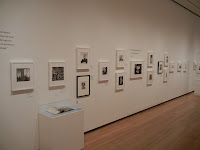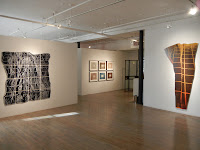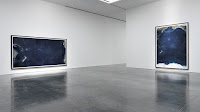 JTF (just the facts): A total of 150 black and white photographs from 73 different photographers, framed in black and matted, and chronologically/thematically displayed against grey, green, yellow, and dark blue walls through a winding series of adjoining gallery spaces. The prints cover the period from roughly 1910 to 1959, with a concentration between 1936 and 1951. An exhibition catalog has been published by Yale University Press (here) and is available in the bookshop for $50. The installation shots at right are courtesy of The Jewish Museum/Christine McMonagle.
JTF (just the facts): A total of 150 black and white photographs from 73 different photographers, framed in black and matted, and chronologically/thematically displayed against grey, green, yellow, and dark blue walls through a winding series of adjoining gallery spaces. The prints cover the period from roughly 1910 to 1959, with a concentration between 1936 and 1951. An exhibition catalog has been published by Yale University Press (here) and is available in the bookshop for $50. The installation shots at right are courtesy of The Jewish Museum/Christine McMonagle.The show is divided into titled sections. These sections and the photographers included are detailed below, with numbers of works and dates in parentheses.
.
.
Precursors
.
Lewis Hine (3, 1910, 1912, 1920)
Lewis Hine (3, 1910, 1912, 1920)
Paul Strand (2, 1915, 1920)
1 video newsreel (1931)
The Great Depression/Harlem Document
The Great Depression/Harlem Document
.
Berenice Abbott (2, 1937)
Berenice Abbott (2, 1937)
Alexander Alland (3, 1938)
Lucy Ashjian (4, 1938, 1939)
Harold Corsini (1, 1939)
Jack Delano (1, 1940)
Robert Disraeli (1, 1934)
Arnold Eagle (1, 1935)
Eliot Elisofon (3, 1937, 1940)
Morris Engel (3, 1937, 1938)
Sid Grossman (2, 1936, 1940)
Rosalie Gwathmey (1, 1940)
Consuelo Kanaga (1, 1937)
Sidney Kerner (1, 1938)
Rebecca Lepkoff (1, 1939)
Richard Lyon (1, 1937)
Jack Manning (2, 1939)
Lisette Model (1, 1940)
Arnold Newman (1, 1940)
Sol Prom (1, 1938)
Walter Rosenblum (3, 1938)
Arthur Rothstein (1, 1935)
Joe Schwartz (2, 1936, 1939)
Lee Sievan (1, 1940)
Aaron Siskind (5, 1937, 1938, 1940)
Rolf Tietgens (1, 1938)
John Vachon (1, 1938)
Dan Weiner (1, 1939)
Max Yavno (1, 1940)
2 glass cases (syllabus, notes, membership cards, newspaper articles, magazine spreads, books)
.
.
The War Years
.
Lou Bernstein (2, 1943, 1947)
Lou Bernstein (2, 1943, 1947)
Bernard Cole (1, 1944)
Harold Feinstein (1, 1945)
Godfrey Frankel (1, 1945)
George Gilbert (1, 1942)
Sid Grossman (2, 1945)
Rosalie Gwathmey (1, 1945)
Morris Huberland (2, 1941, 1942)
Arthur Leipzig (1, 1946)
Rebecca Lepkoff (1, 1947)
Helen Levitt (1, 1940)
Sol Libsohn (1, 1945)
Sonia Handelman Meyer (1, 1946)
Lisette Model (3, 1940, 1942, 1945)
David Robbins (2, 1941, 1944)
Walter Rosenblum (2, 1944)
Edwin Roskam (1, 1944)
Arthur Rothstein (1, 1946)
Fred Stein (1, 1945)
Louis Stettner (3, 1940, 1951)
Lou Stoumen (1, 1940)
Paul Strand (1, 1938)
Elizabeth Timberman (1, 1944)
Weegee (5, 1938, 1940, 1941, 1943, 1945)
Ida Wyman (1, 1945)
4 glass cases (book, installation/judging photos, magazines, brochures, flyers, party photos)
.
.
.
Vivian Cherry (2, 1947)
Vivian Cherry (2, 1947)
Robert Disraeli (1, 1950)
Morris Engel (1, 1947)
Rosalie Gwathmey (1, 1948)
N. Jay Jaffee (1, 1948)
Arthur Leipzig (2, 1949, 1950)
Rebecca Lepkoff (1, 1947)
Sol Libsohn (1, 1949)
Jerome Liebling (2, 1948, 1949)
Tosh Matsumoto (1, 1950)
Sonia Handelman Meyer (2, 1945, 1946)
Ruth Orkin (1, 1948)
Marion Palfi (2, 1948, 1949)
Rae Russel (1, 1947)
Edward Schwartz (1, 1952)
Erika Stone (1, 1947)
David Vestal (1, 1949)
Sandra Weiner (1, 1948)
Ida Wyman (1, 1947)
2 glass cases (newspapers, books, meeting notes, letters, photograph)
.
.
A Center for American Photography
.
Nancy Bulkeley (1, 1946)
Nancy Bulkeley (1, 1946)
Ann Cooper (1, 1950)
Arnold Eagle (1, 1950)
Morris Engel (1, 1938)
Leo Goldstein (1, 1950)
Sid Grossman (2, 1947, 1948)
N. Jay Jaffee (1, 1950)
Sy Kattelson (3, 1948, 1949, 1950)
Rebecca Lepkoff (1, 1948)
Jack Lessinger (1, 1950)
Leon Levinstein (2, undated)
Jerome Liebling (1, 1953)
Sam Mahl (1, 1949)
Phyllis Dearborn Masser (1, 1948)
Marvin Newman (2, 1949, 1951)
Ruth Orkin (1, 1950)
Ann Zane Shanks (1, 1955)
Larry Silver (1, 1951)
W. Eugene Smith (2, 1951)
Louis Stettner (1, 1951)
Dan Weiner (4, 1948, 1949, 1950)
Bill Witt (1, 1948)
Ida Wyman (1, 1950)
Max Yavno (1, 1949)
George Zimbel (1, 1951)
2 glass cases (magazine spreads, Photo Notes, exhibit catalogues, installation/remodeling photos)
1 video film (1953)
1 interactive map
.
.
Coda
.
Sid Grossman (1, 1959)
Sid Grossman (1, 1959)
1 glass case (book, teaching photo)
1 documentary film (2011)
Comments/Context: The short hand story of the New York Photo League has always been a bit too overly easy for my liking: a few notable artistic names, some left leaning politics, and a muddy and inconclusive interpretation of its lasting influence on photography and the history of the city. I think that's why I found this more comprehensive and inclusive retelling to be so much more exciting and useful; it's not just a hackneyed, one-sided narrative about communists, but a broad, interwoven confluence of politics, history, geography, and photography, with a strong undercurrent of healthy artistic debate.
.
.
Walking through the twisting galleries, I found myself thinking about the Photo League in the context of a diagram. From one corner comes the march of history: the Great Depression, World War II, and the Cold War, each with its own very real impacts on daily life in New York. From another corner comes the melting pot of the urban city itself: the people, the individual neighborhoods, the street life of mixed classes, races, religions, and ethnicities. And from a third corner comes the evolution of photography as a medium: the remnants of the between the wars Modernism, the arrival of the flexible hand held camera and the weekly magazines filled with photojournalism, and the beginnings of a more personal and subjective kind of image making. At the center of this diagram sits the New York Photo League, documenting the truths found on the streets of this great city, under the changing pressures of history, tugged in different artistic directions, trying to balance and synthesize these competing forces. Seen in this way, I suddenly started to understand where the Photo League really fits, and why the work on the walls looks the way it does.
This show is roughly chronological, and this design allows the viewer to see the evolving stylistic approaches being employed by League members over the years of the club's existence. Simplistically, one can imagine a continuum, at one end, documentary photography informed by activism, engagement and advocacy, a witness with an ideological purpose and a particular kind of social commentary to put forth. At the other end lies documentary photography informed by more subjective concerns, including individual emotions/reactions, aesthetics, formalism, and more personal questioning. As the years passed from 1936 to 1951 (the beginning and end of the League's operation), it is possible to watch this internal debate raging on, where a new sensibility gradually starts to take hold. This evolving definition of documentary/street photography didn't of course end here; these same issues remain intensely relevant and hotly argued on both sides even today.
With Hine and Strand as artistic precursors and with Abbott as a teacher, it isn't surprising that the Great Depression pictures start with a formal clarity and slowly evolve toward more progressive messages, likely as a result of the crushing economic times. Bridges and storefronts, vacant lots and crumbling tenement buildings, these kinds of subjects slowly give way to more human stories, particularly the Harlem Document pictures, which take a heavier handed look at poverty and unemployment in the black community. While these images are seen today with an eye for their overly negative stereotypes, they still represent a style of activist, engaged street photography that held favor with many of the members at the time.
This show is roughly chronological, and this design allows the viewer to see the evolving stylistic approaches being employed by League members over the years of the club's existence. Simplistically, one can imagine a continuum, at one end, documentary photography informed by activism, engagement and advocacy, a witness with an ideological purpose and a particular kind of social commentary to put forth. At the other end lies documentary photography informed by more subjective concerns, including individual emotions/reactions, aesthetics, formalism, and more personal questioning. As the years passed from 1936 to 1951 (the beginning and end of the League's operation), it is possible to watch this internal debate raging on, where a new sensibility gradually starts to take hold. This evolving definition of documentary/street photography didn't of course end here; these same issues remain intensely relevant and hotly argued on both sides even today.
With Hine and Strand as artistic precursors and with Abbott as a teacher, it isn't surprising that the Great Depression pictures start with a formal clarity and slowly evolve toward more progressive messages, likely as a result of the crushing economic times. Bridges and storefronts, vacant lots and crumbling tenement buildings, these kinds of subjects slowly give way to more human stories, particularly the Harlem Document pictures, which take a heavier handed look at poverty and unemployment in the black community. While these images are seen today with an eye for their overly negative stereotypes, they still represent a style of activist, engaged street photography that held favor with many of the members at the time.
With the arrival of World War II, the subject matter changed again: soldiers, white hatted sailors, mothers, political rallies, crowded protests, blurred motion coming into the frame with more regularity. In these pictures, the aesthetic schism starts to appear more clearly, with some members moving down a more atmospheric path, telling smaller and more marginal stories with empathy, humor, and even dark irony. These are more individual scenes, often environmental portraits, with an increasing level of compositional freedom and experimentation. As the Cold War deepened and the Photo League was blacklisted (and ultimately disbanded a few years later), the stylistic changes became more widespread. Using aerial views, mirrors, reverse angles, silhouettes, complex graphical overlaps, and a host of other approaches, the Photo League's brand of street photography became much more diverse, and by the early 1950s, it bore very little resemblance to the work from the late 1930s. The mood was harsher, the compositions more personal and less purely documentary.
What I like best about this show is its rag tag, unwieldy inclusiveness; there are dozens of names included here that have been largely forgotten, and yet their images fit together into a logical progression that seems fluid with the benefit of time. For me, I finally started to visually understand the small steps that made up the aesthetic and conceptual changes that took place between the 1930s and the 1950s, those missing evolutionary links between Abbott and Frank; The Americans now seems to me less like a thunder strike of genius out of nowhere and more like an innovative, original extrapolation from visual ideas that were already beginning to percolate around. This excellent show tells a uniquely New York story, and is worth a visit simply for the rich historical details of life in the city that it provides. But the reason I found this to be one of the best photography shows of the year is that it also successfully fills in an important (and largely missing) gap in the recounting of the American photographic narrative. Not only do I now have an increased appreciation for the talents of the many members of the New York Photo League (many of whom have been unjustly overlooked), I now understand much more clearly how the larger artistic puzzle fits together.
.
What I like best about this show is its rag tag, unwieldy inclusiveness; there are dozens of names included here that have been largely forgotten, and yet their images fit together into a logical progression that seems fluid with the benefit of time. For me, I finally started to visually understand the small steps that made up the aesthetic and conceptual changes that took place between the 1930s and the 1950s, those missing evolutionary links between Abbott and Frank; The Americans now seems to me less like a thunder strike of genius out of nowhere and more like an innovative, original extrapolation from visual ideas that were already beginning to percolate around. This excellent show tells a uniquely New York story, and is worth a visit simply for the rich historical details of life in the city that it provides. But the reason I found this to be one of the best photography shows of the year is that it also successfully fills in an important (and largely missing) gap in the recounting of the American photographic narrative. Not only do I now have an increased appreciation for the talents of the many members of the New York Photo League (many of whom have been unjustly overlooked), I now understand much more clearly how the larger artistic puzzle fits together.
.
Collector's POV: Given this is a museum show, there are, of course, no posted prices. Given the wide number of included artists, it seems fitting to forego the specific secondary market discussion that usually fills this section.
.
.
Rating: *** (three stars) EXCELLENT (rating system described here)
.
.
Transit Hub:
- Features/Reviews: Wall Street Journal (here), Lens (here), NY Times (here), New Yorker (here), Artnet (here), Photograph (here)
Through March 25th
The Jewish Museum
1109 5th Ave at 92nd St
New York, NY 10128
Administrative Note: This will be the last post of the year. I'll return again in the New Year, beginning with the end of year roundups of the best shows and top photography venues of 2011. Happy Holidays!








































